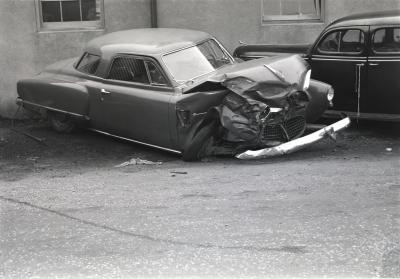
Sad fact of life: ask a simple question of a chassis engineer, and you're almost sure to get a 20-minute answer that still doesn't tell you what you wanted to know. But don't blame the engineer. There are so many factors involved in answering some of the simplest questions that there's almost no way to give a catch-all response. That being said: yes, hitting a speed bump at 90 mph is definitely going to break something.
Imagine, if you will, a hammer driving a nail into a very stiff board. As the hammer's head comes into contact with the nail head, it imparts all of its kinetic -- movement -- energy to the nail. Newton's laws of motion state that, as long as the hammer doesn't bounce back up, the nail goes down into the board. Now imagine that piece of lumber as being very flexible, like a 10-foot-long two-by-four supported only at its ends by a pair of saw horses. Now, you'd find it nearly impossible to drive that nail right into the middle of the wood, because the wood itself will bend to absorb the impact energy of the hammer. To extend this metaphor: the wood is your car's suspension and chassis, the nail is your tire and the speed bump is the hammer.
While anyone with carpentry experience can relate to the above example, the principles behind it bear some examination. Force equals mass times acceleration, or in this case, deceleration. Acceleration is a change in velocity measured over time; if something speeds up or slows down faster than something else, it's accelerating or decelerating faster. The nail goes into the stiff board easily because all of the hammer's energy expresses itself on the nail in about 0.001-second. The flexible board slows that energy transfer down to perhaps 0.50-second, which results in an approximate 50-to-1 reduction in force transmitted. The same holds true for your tire hitting a speed bump.
A number of things will affect how your car reacts to speed bumps. The first and probably most important is vehicle mass. A heavier car is like a bigger hammer, storing more kinetic energy and resisting rebound when it hits the speed bump. Speed is the second crucial variable; get going fast enough -- say, mach three -- and even hitting a pebble in the road will rip your suspension to shreds. The same speed bump that would barely nod your head at 3 mph could easily send your front suspension through the firewall at 60 mph. Then, you have the car's spring and shock absorbers; the harder they are, the faster the deceleration and the more effect on the chassis. Finally, a very heavy wheel/tire/suspension combo will act directly upon the alignment components, transferring a force contingent upon the above factors.
Your car's wheels and tires comprise its unsprung mass, or mass not supported by the springs. This is the mass that comes into direct contact with the road, and it plays a big part in determining how a bump will affect your alignment. Softer springs will decrease deceleration and force imparted, but that only helps to an extent when you're talking about unsprung mass. A very stiff suspension wouldn't allow the unsprung mass to build up much kinetic energy, because most of it would transfer directly to the chassis. So, assuming the suspension survived the initial impact, a stiffer suspension would prevent damage that occurs from rapid suspension rebound. Different cars use different suspension adjustment methods, and some are prone more to damage during the rebound event than during the initial impact. This makes sense when you consider that vehicle suspensions are designed to handle upward stress more than downward.
The heavier your car and the faster you hit the bump, the more energy you're transferring to the suspension and the more likely you are to break something or throw it out of alignment. That's universally true regardless of the car. Reducing unsprung mass with lighter wheels, tires, suspension and brake components will allow your springs to absorb the impact without placing undue stress on the suspension. Bigger tires with taller sidewalls and lower air pressures will help reduce impact stress by absorbing some of it before it ever gets to the suspension, but there's always a trade-off between tire size and tire weight. Softer springs might make the suspension more prone to going out of alignment if the unsprung mass is high and that particular suspension is susceptible to rebound damage, but, for the most part, they can only stand to help most applications.